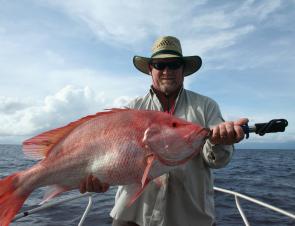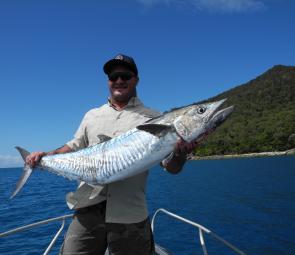July is likely to present Cairns anglers with a continuation of the crappy weather that has dominated this autumn and winter, with an oversupply of southeasters and accompanying showers interspersed with short periods of magic weather. As so often happens in north Queensland, an ordinary wet season is followed by a wet and windy winter. That being said, when the winds drop and the sun shines, all aquatic creatures come out to play, so be ready to grab any opportunity that comes your way. July is not the time to wait for the moon and tides to be just right. When the wind drops, go for it and forget about the rest.
Mackerel will be the main target species for boaties and they can be accessed closer inshore in less favourable conditions than those wanted for reef fishing. Any time the wind dips below 20 knots, it’s worth putting your mackerel hat on and conducting an early morning raid to inshore islands, wrecks and marker leads. Southeasters, which dominate the weather pattern in July, tend to ease slightly early in the morning and turn south to southwest close to shore. The secret is to be on the water before daylight and poking out steadily at first light. The more adventurous will be on site waiting for the first hint of daylight to get a lure, live bait or trolled bait over the side. Mackerel will bite when it’s still so dark that you are using a headlight to see what you are doing in the boat. Between 7am and 9am the southeasters will spring up, then it’s time to head in or stretch it out for another hour or so by trolling back to port.
As is daylight comes, the mackerel will often be up near the surface silhouetting bait, so focus your lures, live or dead baits in the top third of the water column. I like to troll first up, with all eyes on the sounder and surface looking for bait schools or fish marking. If an hour of trolling proves fruitless then it’s time to anchor up in the location showing the best signs of activity and switch to burley and bait fishing. Diced up pilchards or sardines make great burley or there are endless commercially produced burleys to choose from. It pays to keep left over bait each trip as burley for the next outing, as re-frozen bait is not suitable for fishing. As the sun climbs, start working the bottom two thirds of the water column, because the mackerel will tend to feed deeper as the day progresses.
When the weather allows, the best mackerel fishing will tend to be at the reef, with Spaniards as the main players. Lures that run at 5 to 10 metres tend to be most productive, with red, white, blue, black and gold popular colour combinations. Gar and mullet tend to be the most popular trolled baits at the reef but wolf herring, pike, grinner, bonito or any silver fish you can get to troll without twisting will catch mackerel. The advantage of bigger baits is the razor gang of smaller mackerel species tend to leave them alone but small baits will still catch big Spaniards, especially if you are live baiting. If you are chasing bigger fish using sardines or small mullet for live bait, it’s best to troll. Drift fishing smaller live baits will tend to attract more school and spotted mackerel than Spaniards. In the bigger live bait department, fusiliers, hussar, any trevally species and most small bottom fish will make the grade. Remember, live baits still have to meet the legal size requirements.
Mackerel are not the only pelagics on the rampage in July, with monster GT, bonito, tuna and cobia around in good numbers, especially out towards the shelf. Light tackle enthusiasts will also find yellow fin tuna and the odd small billfish out wide.
When the winds fade away, the reef is the place to be, with plenty on offer in both the shallow and deep water. Up shallow the trout will be feeding up in preparation for spawning, with a mix of sweetlip, Moses perch, stripies, trevally of all shapes and sizes and spangled emperor adding variety to the catch. In the deeper water, red emperor and large-mouth nannygai will be the main target species, with quality fish on offer, especially at night. At times, large-mouth in particular, can be very picky and hard to hook. You will feel them sucking on the bait but not engaging. A couple of tactics worth trying are letting the line go very loose when you feel the initial bite, even free spooling in the right country. Another approach is to downsize the line and/or bait. Go to a lighter line and/or smaller bait and hook. A smaller bait will often tempt them to swallow it and take off rather than sit there and suck on the bait for ages.
The reality of winter fishing in the north is that most of the time you will be restricted to sheltered waters around the inlet and estuaries, with the humble bream reliable target species. Any manmade structure like rock walls and pylons will hold bream along with any rubble or rocky bottom. The rising tide tends to fish best, with plenty of trevally and queenfish also coming in on the bigger tides. Fishing for these species tends to be better near the mouth when the water is clearer, so winds up around the strong wind warning aren’t suitable. The odd golden trevally will be poking around the systems and they will really test your gear in confined space. You are better off poking upstream looking for warm still areas when the winds are howling. There will still be the odd barra, golden snapper and mangrove jack about for the dedicated or very patient, with structure in deep water the best place to look. These more tropical species will bite best on those same magical, still, sunny winter days where the piscatorial magnet is dragging you offshore.
Crabbing is a great option when the winds blow and provided there is no fresh in the system look up the top of the streams on the bigger tides around the full and new moons as a starting point. If that fails, try around the mouths, especially on the biggest of the tides or when there is a fresh in the system.
Reads: 1375
Changing to a smaller bait can often entice big mouth nannygai, like this beauty caught aboard Blackout Sportsfishing Charters, to swallow the bait and take off, rather than sit a and suck on the bait.

Mackerel will be the main target species in July, so whenever the wind drops below 20 knots head to the more protected inshore mackerel grounds early in the morning.




